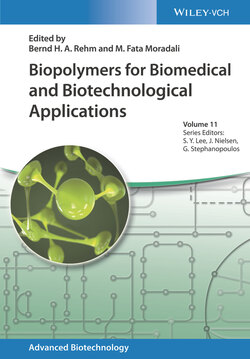Читать книгу Biopolymers for Biomedical and Biotechnological Applications - Группа авторов - Страница 48
2.7 Applications of Chitinous Polymers 2.7.1 Chitin, Chitosan, and Chitinous Polysaccharides
ОглавлениеChitin is the second most abundant polysaccharide available in nature after cellulose. Composed of N‐acetyl‐D‐glucosamine and N‐glucosamine units (Figure 2.5), this polysaccharide can be found on both animal and microbial sources. The chitin extracted from microorganisms is advantageous over the chitin from animal sources, due to several factors: the microbial cultures achieved high growth rates and high cell densities, there is no seasonality of the raw material, the composition of polysaccharide is more stable and controllable, and the microbial chitin is allergen‐free, which is very important in case of pharma/biomedical applications [207].
Figure 2.5 Deacetylation reaction of chitin to chitosan.
Source: Croisier and Jérôme 2013 [206]. Reproduced with permission of Elsevier.
Microbial chitin is a cell‐wall component of several yeast and fungi strains, conferring rigidity and protection to the cells [208,209]. Depending of the fungal source, chitin can achieve a cell‐wall content up to 60% on a dry basis [207]. It is also possible to find chitin polysaccharides in some algae species [210,212].
Fungal chitin can also be found covalently linked to β‐glucans to form chitin complexes such as chitin–glucan complex (CGC) [208,213]. Among the microbial cultures that can be used as chitin/chitinous polysaccharide sources are filamentous fungi (e.g. Aspergillus niger, Aspergillus fumigatus, Rhizopus oryzae, Mucor rouxii) [213,217], mushrooms (e.g. Ganoderma lucidum, Agaricus bisporus, Schizophyllum commune) [218,221], and yeasts (e.g. Saccharomyces cerevisiae, Komagataella (Pichia) pastoris, Candida albicans) [216,222–224]. The chitinous polysaccharide extraction from fungal cell walls can be performed with mechanical and/or nonmechanical methods. Some examples of mechanical methods are high‐pressure homogenization, bead mill, or ultrasound, while the nonmechanical methods include the alkaline hydrolysis (with NaOH or KOH as solvents) or enzymatic treatments [225].
Chitosan is the most known chitin derivative, obtained from the deacetylation reaction of chitin, in high alkali and temperature conditions or by enzymatic hydrolysis (Figure 2.5) [226,228]. Depending on the alkaline treatment performed for fungal cell‐wall lysis, the extraction procedure can also result in the extraction of chitosan or chitosan–glucan complex (ChGC) [215,221,229,230].
